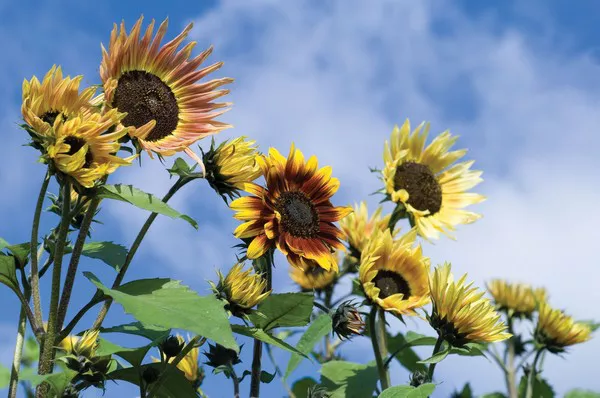Sunflowers are one of the most iconic and cheerful flowers in the plant kingdom, known for their vibrant golden blooms that follow the sun throughout the day. Growing sunflowers from seeds is a rewarding and enjoyable gardening project that can brighten up any garden or landscape.
Choosing the Right Sunflower Variety
Before you start your sunflower-growing journey, it’s essential to select the right sunflower variety for your specific needs and preferences. There are various sunflower types to choose from, each with its unique characteristics:
a. Giant Sunflowers: These towering sunflowers can reach heights of 12 feet or more and have large, impressive blooms.
b. Dwarf Sunflowers: Ideal for smaller spaces or container gardening, dwarf sunflowers are compact and easy to manage.
c. Sunflowers for Cut Flowers: These sunflowers are specifically bred for long, sturdy stems, making them excellent for floral arrangements.
d. Pollinator-Attracting Sunflowers: Some sunflower varieties are particularly attractive to pollinators, making them a great addition to a wildlife-friendly garden.
Sunflower Seed Selection
When selecting sunflower seeds, there are a few factors to consider:
a. Seed Quality: Choose high-quality sunflower seeds from reputable suppliers to ensure a successful germination and healthy growth.
b. Sunflower Color: Consider the color of the sunflower blooms, whether you prefer classic yellow, vibrant red, or even unique multi-colored varieties.
c. Sunflower Size: Depending on your space and purpose, select seeds for the desired sunflower height, from towering giants to compact dwarfs.
Preparing the Planting Site
Sunflowers thrive in full sun, so it’s crucial to choose a location that receives at least 6-8 hours of direct sunlight per day. Follow these steps to prepare the planting site:
a. Clear the Area: Remove any weeds, rocks, or debris from the planting area, ensuring a clean slate for your sunflowers.
b. Soil Preparation: Sunflowers prefer well-draining soil with a pH level between 6.0 and 7.5. Amend the soil with organic matter, such as compost, to improve fertility and drainage.
c. Spacing: Depending on the sunflower variety, leave adequate space between seeds or plants. For giant sunflowers, space them about 2-3 feet apart, while dwarf varieties can be planted closer together.
Planting Sunflower Seeds
Now that your site is ready, it’s time to plant your sunflower seeds. Follow these steps for successful seed sowing:
a. Sow Depth: Sunflower seeds should be planted at a depth of about 1 inch. Space the seeds 6-12 inches apart, depending on the variety.
b. Watering: After planting the seeds, water the area thoroughly to ensure good seed-to-soil contact. Keep the soil consistently moist until the seeds germinate.
c. Mulching: Apply a layer of mulch to help retain soil moisture and prevent weed growth. Mulching also protects the seeds from birds and other seed-eating animals.
Germination and Early Care
Sunflower seeds typically germinate within 7-10 days, but it can vary depending on temperature and soil conditions. During this phase, it’s essential to provide proper care to ensure healthy seedlings:
a. Thinning: Once the seedlings are a few inches tall, thin them by removing weaker plants, leaving the healthiest and strongest ones.
b. Watering: Keep the soil consistently moist but avoid overwatering, which can lead to root rot.
c. Fertilization: Sunflowers are not heavy feeders, but a balanced, slow-release fertilizer can be applied during the growing season to encourage healthy growth.
Sunflower Maintenance
Maintaining your sunflowers is relatively straightforward, but there are some key aspects to consider:
a. Watering: As your sunflowers grow, water them deeply but less frequently. Allow the soil to dry slightly between waterings to promote deep root development.
b. Support: For tall varieties or those in windy locations, it’s a good idea to provide support with stakes or trellises to prevent them from toppling over.
c. Deadheading: Removing spent flowers (deadheading) encourages continuous blooming and prevents self-seeding if you prefer to control where your sunflowers grow.
d. Pest and Disease Management: Monitor your sunflowers for common pests such as aphids, caterpillars, or birds. Address issues promptly to prevent damage.
Harvesting Sunflowers
The moment you’ve been waiting for is here – harvesting your sunflowers. The timing for harvesting depends on the intended use:
a. For cut flowers: Harvest sunflowers when the petals are fully open but not yet wilting, and the center is packed with seeds. Cut the stems at a 45-degree angle and place them in a vase with water.
b. For seeds: If you’re growing sunflowers for their edible seeds, wait until the flower head droops and the back of the head turns yellow. Cut the head and allow it to dry in a warm, well-ventilated area. Once dry, remove the seeds by rubbing them off or using a fork.
Saving Sunflower Seeds
If you want to save sunflower seeds for the next season, follow these steps:
a. Dry the Seeds: Once you’ve removed the seeds from the flower head, spread them out on a tray or paper towel to air dry for about a week.
b. Storage: Store the dried seeds in an airtight container in a cool, dark place until you’re ready to plant them in the next growing season.
Troubleshooting Common Issues
While sunflowers are relatively easy to grow, they can encounter common issues such as:
a. Bird damage: Birds may be attracted to the seeds or seedlings. Consider using bird netting or scare tactics to deter them.
b. Powdery mildew: This fungal disease can affect sunflowers. Ensure good air circulation and, if necessary, use a fungicide.
c. Aphids: These small insects can cluster on sunflower leaves and stems. Spray them off with a strong stream of water or use an insecticidal soap.
Conclusion
Growing sunflowers from seeds is a delightful and satisfying gardening experience. With the right variety, proper planting and care, and a little patience, you can enjoy the sight of these radiant blooms in your garden. So, whether you’re looking to create a stunning garden display, attract pollinators, or harvest sunflower seeds for a tasty snack, get ready to enjoy the vibrant beauty of sunflowers in your own outdoor space.


